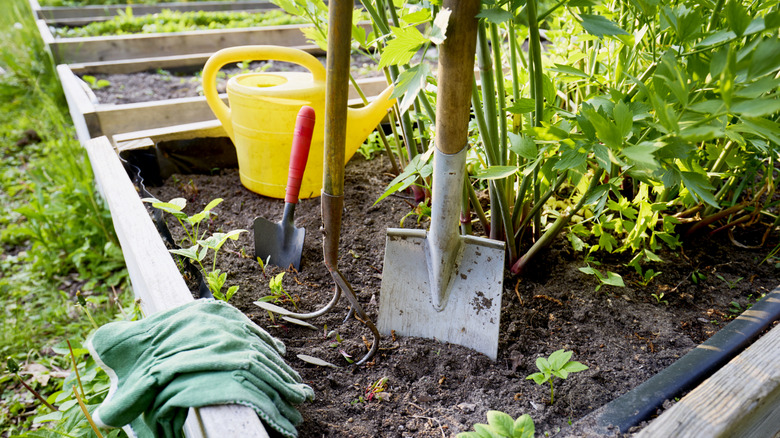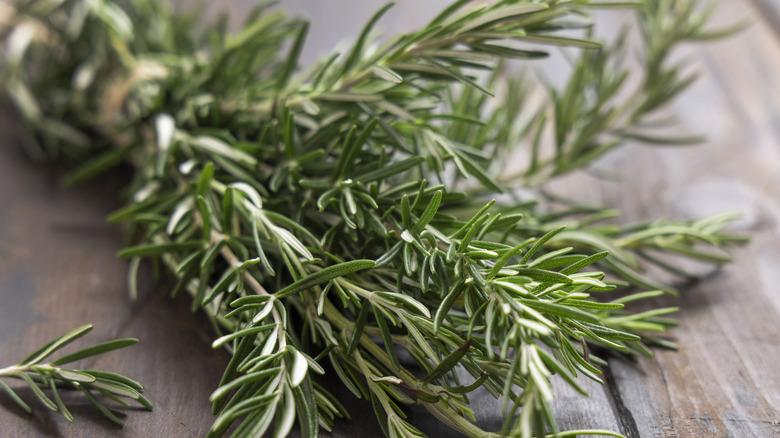The Popular Herb You Should Never Plant In Shade
Rosemary (Salvia rosmarinus), a staple in herb gardens and a beloved aromatic indoor plant, thrives in full sun — it needs a minimum of six hours of direct sunlight daily to grow well. Without hours of sunlight each day, the plant may get leggy, fail to produce flowers, or lack flavor — likely not the results you're hoping for in your herb garden. There is one exception to the sunlight rule, though. In climates where the temperatures regularly climb into the 90s and higher, rosemary plants can become stressed. If that's the case where you live, giving the plant some afternoon shade should keep it healthy.
When grown in ideal conditions with plenty of sun, rosemary has a bold flavor with hints of different herbs, including mint, sage, and pepper. It's often described as an earthy or woody flavor. Uses for easy-to-grow rosemary extend beyond the popular herb's culinary contribution to dishes like roast lamb, homemade bread, and oven-baked vegetables. The pungent plant is used in beauty products and essential oils, as a treatment for various ailments, and as a symbol for remembrance.
With enough sunlight, the tiny blue, purple, white, and sometimes pink flowers of rosemary bloom in spring and winter. The perennial evergreen attracts pollinators and grows well in rock gardens and, in the warmest zones, as part of a winter garden. Grown outdoors or in containers inside, the scent of rosemary is reminiscent of pine forests. Not only is the plant easy to grow, its resistance to drought, deer, salt air, and slugs makes it a welcome addition to the landscape.
Growing rosemary indoors and out
Rosemary is hardy in zones 8 to 10. While six hours of direct sun is the minimum, rosemary does well with even more. When you're choosing a garden spot for your rosemary, observe buildings or trees and shrubbery that may shade the plant. Aside from at least six hours of sunlight a day, rosemary, needs acidic soil with a high organic content to thrive. The soil should be well-drained, as it is in its native Mediterranean region, and you can keep your rosemary plants thriving all season long by letting the soil dry out between watering.
Mature rosemary bushes can grow to 5 feet tall and 4 feet wide and rarely need fertilizer. If the plant starts to yellow or fails to grow, use an all-purpose fertilizer, taking care not to allow it to touch the plant's leaves. One solution to keeping your rosemary alive year-round in cooler climates is to put the plant, pot and all, in the soil in the spring and then dig it up in the fall to bring inside.
If you don't have a sunny location to grow rosemary outdoors, it can be grown indoors in a bright, south-facing window or under DIY grow lights for indoor plants. Indoor plants need daytime temperatures between 65 and 75 degrees Fahrenheit and nighttime temperatures between 55 and 60 degrees Fahrenheit. Since most indoor spaces lack enough humidity for plants in the winter, set the rosemary on a single layer of pebbles in a pot saucer filled with water. Make sure the pot has good drainage, and let the rosemary dry out a little bit between waterings. If your rosemary is growing on a window sill, rotate the pot often so that each side is exposed to the light equally.

